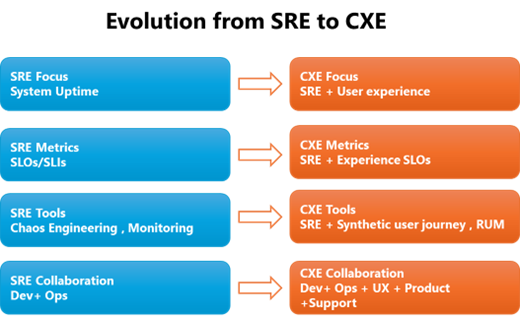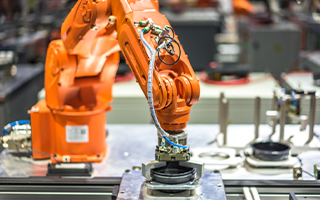From SRE to CXE: Engineering Reliability for Human-Centered Digital Experiences

The SRE Legacy: A foundation, not the destination
When Google came up with Site Reliability Engineering (SRE), it completely changed how IT operations are done. Instead of relying on gut feelings, they brought in a more scientific way to manage reliability. They introduced key metrics like SLOs (Service Level Objectives), SLIs (Service Level Indicators), Error Budgets, MTTR (Mean Time to Recovery), and Change Success Rate. These help teams keep track of how their services are doing and make smarter decisions to keep things running smoothly. This model accelerated cloud adoption and became the backbone of digital resilience.
However, ask ten organizations "What is SRE?" and you’ll probably get twelve answers. SRE might be:
- An observability team
- An infrastructure resiliency team
- An automation team
- A performance testing function
- A subset of the DevOps or CICD team
- Part of a broader platform engineering team
This fragmentation compels you to confront a critical question: who is the true customer of Site Reliability Engineering (SRE)? Is it the developers who rely on reliable systems to build and deploy applications efficiently? Or the platform owners responsible for infrastructure stability and scalability? Perhaps it’s the business stakeholders seeking performance, uptime, and customer satisfaction? Or ultimately, is it the end-users who experience the direct impact of system reliability? The answer is all of them, because all ultimately serve one goal: customer experience and delight.
The Blind Spot: Reliability ≠ Experience
Infrastructure uptime and app performance are necessary, but insufficient. Users don’t celebrate "five-nines availability" if ‘Checkout flows silently fail’ or ‘Search results load inconsistently’ or ‘UI latency frustrates mobile users’ or say, ‘Error messages confuse instead of guiding’.
The problem is that downtime is obvious. But a poor experience? That’s sneaky. A mere 100ms delay can tank conversion rates. A clunky workflow chips away at user trust. And this is where traditional SRE hits a wall—because reliability alone doesn’t guarantee a great experience.
Introducing the CXE: Customer Experience Engineer
Customer Experience Engineering (CXE) is a natural evolution of SRE, where the focus shifts from system metrics to user-centric outcomes. It’s not just about reliability; it’s about delight.
| Questions an SRE asks | Questions a CXE asks |
|---|---|
| Is the system up? | Is the user transaction succeeding? |
| Are SLIs green? | Is the experience frictionless? |
| Can we handle the load? | Does this feel reliable? |
This is where the CXE calls for a shift in mindset:
- Scope → End-to-end user journeys (not siloed services)
- Metrics → Experience SLOs (e.g.: Search completes in <1s, Checkout success rate >99.2%)
- Ownership → Business-outcome alignment (retention, conversion, NPS)
Site Reliability Engineering (SRE) applies software engineering principles to IT operations to build scalable, reliable, and efficient systems.
Customer Experience Engineering (CXE) builds on SRE principles by integrating proactive user empathy, customer-impact-driven metrics, and continuous feedback loops—shifting the focus beyond system reliability to delivering a consistent and delightful user experience.
CXEs Operate Beyond Traditional Tooling
CXEs inherit SRE’s technical foundation but expand the toolkit:
| Typical SRE Toolkit | CXE Evolution Additions |
|---|---|
| Infrastructure monitoring | Real-user monitoring (RUM) |
| Logging/Alerting | Session replay & heatmaps |
| Chaos engineering | Synthetic user journey tests |
| Incident postmortems |
Customer feedback loops |
For instance, CXE correlates payment API latency with cart abandonment rates and then ‘engineers’ the required solutions, working with the product teams.
Why Does This Evolution Matter Now?
- Competitive differentiation: In saturated markets, experience is the moat
- Revenue protection: 74% of consumers switch after poor digital experiences
- Developer velocity: CXE insights prevent "reliable but irrelevant" features
Becoming a CXE: Where To Start?
This isn’t a title change, but it is a strategic pivot:
- Map critical user journeys (e.g., new user onboarding)
- Define Experience SLOs tied to business KPIs
- Instrument real-user telemetry (e.g., Fullstory, Glassbox)
- Embed CXE principles in SRE/DevOps workflow:
- Include UX in incident reviews
- Prioritize backlog using experience data
- Measure what matters: Track CES (Customer Effort Score), not just uptime
Conclusion: Reliability’s North Star is ‘Human’
It’s time to reframe reliability, not just as a technical metric, but as a human experience. Start by mapping your user journeys, defining experience SLOs, and embedding CXE into your engineering DNA. The future belongs to teams that obsess over customers or users.
What’s your take? Has your organization started measuring reliability through the user’s lens?


















